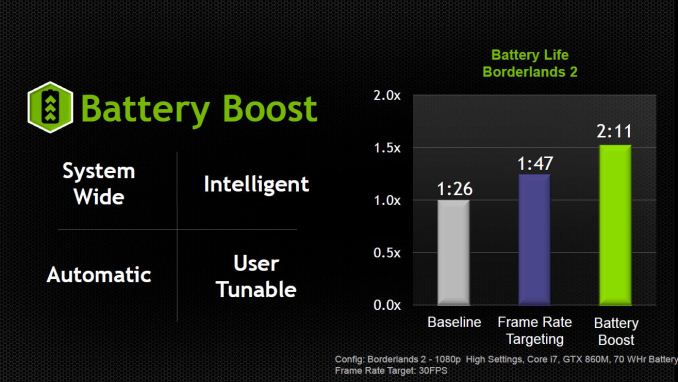NVIDIA’s GeForce 800M Lineup for Laptops and Battery Boost
by Jarred Walton on March 12, 2014 12:00 PM ESTNew for GTX 800M: Battery Boost
While the core hardware features have not changed in most respects – Maxwell and Kepler are both DX11 parts that implement some but not all of the DX 11.1 features – there is one exception. NVIDIA has apparently modified the hardware in the new GTX 800M chips to support a feature they’re calling Battery Boost. The short summary is that with this new combination of software and hardware features, laptops should be able to provide decent (>30 FPS) gaming performance while delivering 50-100% more battery life during gaming.
This could be really important for laptop gaming, as many people have moved to tablets and smartphones simply because a laptop doesn’t last long enough off AC power to warrant consideration. Battery Boost isn’t going to suddenly solve the problem of a high-end GPU and CPU using a significant amount of power, but instead of one hour (or less) of gaming we could actually be looking at a reasonable 2+ hours. Regardless, NVIDIA is quite excited to see where things go with Battery Boost, and we’ll certainly be testing the first GTX 800M laptops to provide some of our own measurements. Let’s get into some of the details of the implementation.
First, Battery Boost will require the use of NVIDIA’s GeForce Experience (GFE) software. You can see the various settings in the above gallery, though the screenshots are provided by NVIDIA so we have not yet been able to test this. Battery Boost builds on some of the already existing features like game profiles and optimizations, but it adds in some additional tweaks. Each GFE game profile on a laptop with Battery Boost will now have options for plugged in and battery power settings, and along with that setting is the ability to set a target frame rate (with 30 being commonly recommended as a nice balance between smoothness and reducing power use).
NVIDIA went into quite a bit of detail explaining how Battery Boost is more than simply targeting a lower average frame rate. That’s certainly a large part of the power savings, but it’s more than just capping the frame rate at 30 FPS. NVIDIA provided some information with a test laptop running Borderlands 2 where the baseline measurement was 86 minutes of battery life; turning on frame rate targeting at 30 FPS improved battery life by around 25% to 107 minutes, while Battery Boost is able to further improve on that result by another 22% and deliver 131 minutes of gameplay.
NVIDIA didn’t reveal all the details of what they’re doing, but they did state that Battery Boost absolutely requires a new 800M GPU – that’s it’s not a purely software driven solution. It’s an “intelligent” solution that has the drivers monitoring all aspects of the system – CPU, GPU, RAM, etc. – to reduce power draw and reach maximum efficiency. I suspect some of the “secret sauce” comes by way of capping CPU clocks, since most games generally don’t need the CPU running at maximum Turbo Boost to deliver decent frame rates, but what else might be going on is difficult to say. It also sounds as though Battery Boost requires certain features in the laptop firmware to work, which again would limit the feature to new notebooks.
Besides being system wide and intelligent, NVIDIA has two other “talking points” for Battery Boost. It will be automatic – unplug and the Battery Boost settings are enabled; plug in and you switch back to the AC performance mode. That’s easy enough to understand, but there’s a catch: you can’t have a game running and have it switch settings on-the-fly. That’s not really surprising, considering many games require you to exit and restart if you want to change certain settings. Basically, if you’re going to be playing a game while unplugged and you want the benefits of Battery Boost to be active, you’ll need to unplug before starting the game.
As for being user tunable, the above gallery already more or less covers that point – you can customize the settings for each game within GFE. I did comment to NVIDIA that it would be good to add target frame rate to the list of customization options on a per-game basis, as there are some games where you might want a slightly higher frame rate and others where lower frame rates would be perfectly adequate. NVIDIA indicated this would be something they can add at a later date, but for now the target frame rate is a global setting, so you’ll need to manually change it if you want a higher or lower frame rate for a specific game – and understand of course that higher frame rates will generally increase the load on the GPU and thus reduce battery life.
There’s one other aspect to mobile gaming that’s worth a quick note. Most high-end gaming laptops prior to now have throttled the GPU clocks when unplugged. This wasn’t absolutely necessary but was a conscious design decision. In order to maintain higher clocks, the battery and power circuitry would need to be designed to deliver sufficient power, and this often wasn’t considered practical or important. Even with a 90Wh battery, the combination of a GTX-class GPU and a fast CPU could easily drain the battery in under 30 minutes if allowed to run at full performance. So the electrical design power (EDP) of most gaming notebooks until now has capped GPU performance while unplugged, and even then battery life while gaming has typically been less than an hour. Now with Battery Boost, NVIDIA has been working with the laptop OEMs to ensure that the EDP of the battery subsystem will be capable of meeting the needs of the GPU.
Your personal opinion of Battery Boost and whether or not it’s useful will largely depend on what you do with your laptop. Presumably the main reason for getting a laptop instead of a desktop is the ability to be mobile and move around the house or take your PC with you, and Battery Boost should help improve the mobility aspect for gaming. If you rarely/never game while unplugged, it won’t necessarily help in any way but then it won’t hurt either. I suspect many of us simply don’t bother trying to game while unplugged because it drains the battery so quickly, and potentially doubling your mobile gaming time will certainly help in that respect. It’s a “chicken and egg” scenario, where people don’t game because it’s not viable and there’s not much focus on improving mobile gaming because people don’t play while unplugged. NVIDIA is hoping by taking the first step to improving mobile battery life that they can change what people expect from gaming laptops going forward.



















91 Comments
View All Comments
JarredWalton - Thursday, March 13, 2014 - link
I've never been much of a fan of SLI in laptops. Scaling is never perfect, often there is more difficulty with drivers and game compatibility, and battery life can take a hit as well. I mentioned it didn't support SLI, but I can't say it bothers me much. 860M Maxwell supports it (apparently) and will use the same chip, so really it's only going to be a small bump in price to go from two 850M to two 860M -- assuming an OEM wants to do SLI 860M that is.Harmattan - Wednesday, March 12, 2014 - link
I think the thesis of this article is right on: it's a great time for gaming notebooks. The idea just four years ago that I could play the newest games at highest settings at 2560x1600 at more than respectable FPS was unthinkable. My Sager with dual 780ms does that with legs to spare, and I should be able to do this with a SINGLE GPU once high-end Maxwell mobile chips come later this year -- simply amazing.IntelUser2000 - Thursday, March 13, 2014 - link
"we’re talking about a feeble 16GB/s of memory bandwidth – that’s lower than what most desktops and laptops now have for system memory, as DDR3-1600 with a 128-bit interface will do 25.6GB/s."Actually the shared aspect in iGPU systems effectively makes the bandwidth equal to about half that. That is, 12.8GB/s.
JarredWalton - Thursday, March 13, 2014 - link
Only if you're using the iGPU to do something, but since I'm discussing system bandwidth vs. GPU bandwidth I didn't get into that. I suppose something like Kaveri will end up with about the same 16GB/s of bandwidth from the system RAM (with the remaining bandwidth going to the CPU), but really Kaveri will still only be a "moderate" GPU performance level.lmcd - Thursday, March 13, 2014 - link
Since when has Fermi been die shrunk? The 820 needs fact-checked.Ryan Smith - Thursday, March 13, 2014 - link
Since 2012. They released a 28nm version of GF108: GF117.http://www.anandtech.com/show/5697/nvidias-geforce...
jasonelmore - Thursday, March 13, 2014 - link
First Maxwell SLI Enabled GPU!!! and its in a LAPTOP WTFfteoath64 - Thursday, March 13, 2014 - link
Does anybody see why Maxwell part is the starting point and Kepler holding the higher end of the range ?. They are squeezing blood out of Kepler before a complete switch to Maxwell. It is a very clever trick to pull and buys NV time to carefully craft the performance of higher end Maxwell parts to suit the performance/price model they wanted. This release alone seems enough to maintain their discrete gpu market on laptops while AMD struggles with their mobile market. It keeps Intel IGP at bay except for non gamers who do not care about discrete graphics.hero4hire - Thursday, March 13, 2014 - link
I am one of those people that think laptop gaming "is a joke" still. 1hr gaming is still limited but more so is most gamers are going to want to use a mouse not trackpad and therefore use a table. At the point you're gaming at a table why not build a solid desktop and buy an ultraportable for less? Are people unable to spend a 1k to 2k budget better in this regard?I am greatful to see real performance hitting laptops, lower 850m = 580m in the illustration for example. Coming from a purely cost sense I am unconvinced an upgradable desktop and cheap slim low power laptop is not better for the vast majority while also being cheaper. Especially in the long run as you can upgrade a desktop while a $200-$300 laptop won't depreciate like a 1k-2k one will. For example, who is going to buy that 580m laptop for even half its list now? A cheap laptop is almost always worth $100.
lordmocha - Sunday, March 16, 2014 - link
most play plugged into the power and with an external mouseyet the reason to get a gaming laptop (not gaming desktop + laptop) is that it can be cheaper (though performance will be worse), and that it is very portable to take to a friends house